You must have seen a ladybug in your lifetime. In my childhood days, I used to sit on the grass and admire these beauties. I wondered at that time why they were so colorful, and their spotted appearance drew me so much toward them.
But do you know that there are some other bugs that mimic or look like these ladybugs? So I searched for such bugs and compiled a list of 10 bugs that look like ladybugs.
Here is the following article, which discusses the differentiation between ladybugs and bugs that look like ladybugs.
I. Ladybugs
a) Identification
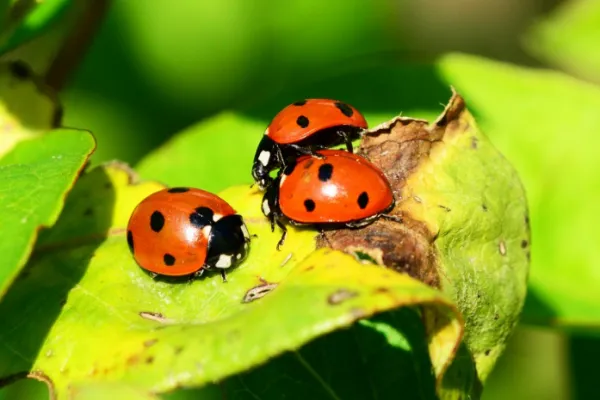
Ladybugs are members of the Coccinellidae family. Normal people frequently misidentify them as bugs; however, they are not actual bugs.
Depending on the region, they are called by different common names; in North America, they are known as ladybugs, whereas in the United Kingdom and Europe, they are referred to as ladybirds.
One can identify them by their small size and round shape with a dome-like appearance. Depending on the species, the majority of them are brightly colored, such as red, orange, yellow, and even black. Spots can also be found on their dorsal surface.
Here’s a table with further information about this little creature:
| Family | Coccinellidae |
| Common name | Ladybugs |
| Size | 0.8 to 18 mm (0.03–0.7 in) |
| Habitat | In various habitats like forests, meadows, grasslands, mountains, gardens, agricultural fields, etc. |
| Diet | Aphids, small insects, small spiders, mites, etc. |
| Predators | Birds, frogs, wasps, spiders, and dragonflies |
| Colors | Mostly red in color with black spots but also exist in other colors |
| Weight | 0.2 grams |
| Life span | up to 1 year |
| About it | They can eat 5000 aphids in their lifetime |
b) Difference between Asian Lady Beetles and Ladybugs
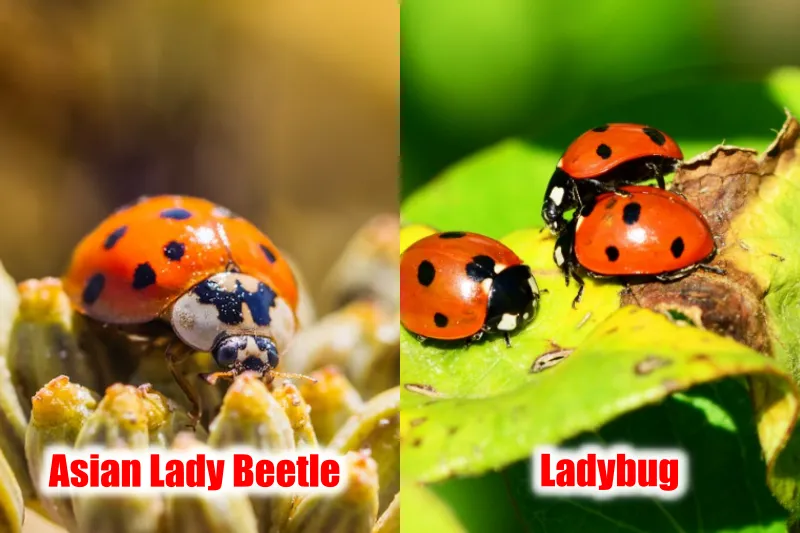
Asian Lady Beetle |
Ladybugs |
|
|
|
|
|
|
|
|
|
|
c) Habitat
Ladybugs live in a variety of environments across the world. The eating habits of the species, the location of their prey, and a good site to mate are some of the elements that influence their habitat.
They are found in forests, meadows, grasslands, mountains, gardens, and agricultural areas, among other places.
d) Are ladybirds and ladybugs the same?
Yes, ladybirds and ladybugs are the same. They belong to the Coccinellidae family of beetles. The differences between ladybirds and ladybugs are regional.
In North America, this creature is called a ladybug, and in Britain and Europe, it is called a ladybird.
They are considered beneficial to farmers as they feed on aphids and other plant pests.
e) Names of Common ladybugs in the United States
- Asian Lady Beetle (Harmonia axyridis)
- Seven-spotted Lady Beetle (Coccinella septempunctata)
- Convergent Lady Beetle (Hippodamia convergens)
- Spotted Pink Ladybeetle (Coleomegilla maculata)
- Spotless Lady Beetle (Cycloneda sanguinea)
- Ashy Gray Lady Beetle (Olla v-nigrum)
II. 10 Bugs That Look Like Ladybugs
1. Argus Tortoise Beetle
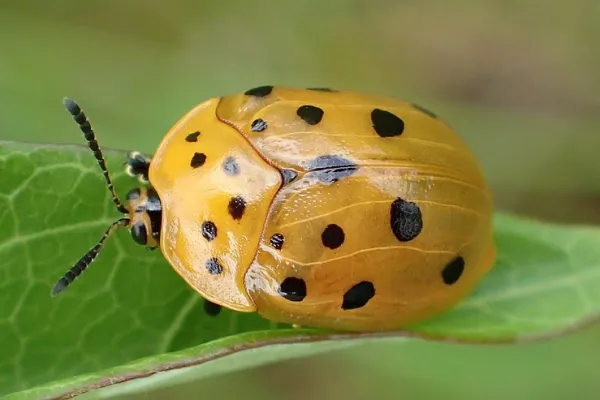
| Scientific name | Chelymorpha cassidea |
| Identification | Have yellow elytra with 11 black spots |
| Location | Caribbean and North America |
This Caribbean and North American native beetle species is one of the biggest beetle species, measuring 9 to 12 mm in length.
This beetle’s name is derived from the mythical Greek giant Argus Panoptes.
They got alkaloids from Morning Glory, which they used to protect themselves from predators.
By appearance, they resemble ladybugs so much. They can also stretch their heads from their pronotum, just like turtles.
2. Ladybird mimicking spider
| Scientific name | Paraplectana tsushimensis |
| Identification | has a red body with black spots |
| Location | China, Japan, and Taiwan |
Just see the picture of this spider. Doesn’t it resemble the ladybug in appearance? Meet this little Paraplectana tsushimensis.
You can easily spot them in Southeast Asian regions like China, Japan, and Taiwan.
They got its name from the common site on Tsushima, an island located between Japan and South Korea.
This spider has a red body with black spots and a dome-shaped body, just like ladybugs.
The only difference that distinguishes them from ladybugs is their head coloration, which is vividly colorful.
3. Golden tortoise beetle
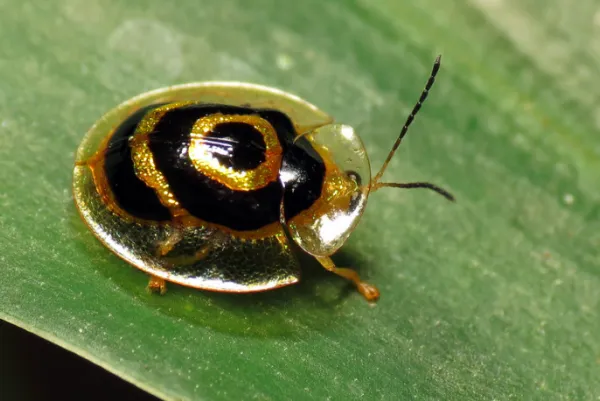
| Scientific name | Charidotella sexpunctata |
| Identification | Gold metallic in color |
| Location | United States, Canada, and Mexico |
Have you heard about the golden beetle in some cartoon series or movies? Have you ever imagined them in real life? Here are golden tortoise beetles, which are known for their unique and brilliant metallic golden coloration.
This species is 5 to 7 mm in length and is commonly found in North America, from Mexico to Canada.
They resemble ladybugs in terms of size and shape. The fecal shield is the distinctive feature of their larvae, which hides them from predators.
4. Spotted cucumber beetle

| Scientific name | Diabrotica undecimpunctata |
| Identification | yellow-green in color with 12 black spots on its elytra |
| Location | North America |
Just looking at the picture, you might confuse them with yellow ladybugs, as their yellow orangish body with black spots on their elytra closely resembles them.
This species is considered one of the major agricultural pests in North America. They primarily eat the leaves of certain plants, including squash, cucumbers, soybeans, cotton, beans, and corn.
Called cucumber beetles, as they lay their eggs near the cucumber plant.
Antennal stroking plays a very important role in courtship in this species of beetle.
5. Swamp milkweed leaf beetle
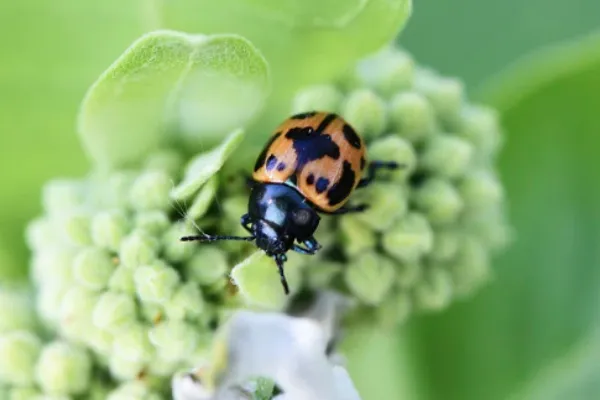
| Scientific name | Labidomera clivicollis |
| Identification | Have black patches on the red forewing |
| Location | eastern Maritimes Provinces and eastern United States |
Resembles the red ladybugs the most. They have orangish-red coloration, and black splotches are present on their elytra, just like ladybugs.
The adults of this species attain a size of up to 12 to 13 mm and are commonly found in the eastern half of the Nearctic region, including the eastern maritime provinces and the eastern United States.
6. Bean leaf beetle

| Scientific name | Cerotoma trifurcata |
| Identification | Have 12 spots on their yellow Elytra |
| Location | Eastern and West United States |
The bean leaf beetle is commonly found in woodlots, clumps of grass, dried curled leaves in leaf litter, and soil under leaves.
They exhibit a wide range of coloration, from light gray to orangish red, and attain a size of up to 3.5 to 5.5 mm.
Their spotted appearance made them closely related to ladybugs. The bean leaf beetle is mostly found in alfalfa, bean, and soy crops.
7. Ladybird bug

| Scientific name | Steganocerus multipunctatus |
| Identification | Have bright orange spots on the black body |
| Location | Sub Saharan Africa |
The ladybird bug got its name due to its resemblance to ladybirds in terms of shape, size, and coloration. They are black in color with bright orange spots on their elytra. It is commonly found in sub-Saharan Africa, inhabiting cotton fields.
8. False ladybird

| Scientific name | Endomychus coccineus |
| Identification | Have two spots on each elytra, just like Ladybird |
| Location | In Europe |
Both Endomychus coccineus and ladybirds are known for their striking and often brightly colored appearances.
They are glossy red in color, with two spots on each elytra, just like a ladybird.
The only difference between them is their body shape; they are flatter in shape than ladybirds, which are dome-shaped.
They primarily feed on wood mushrooms, like old birch and beech stumps. You can find them in Europe in the months of April and June.
9. Asian lady beetle
| Scientific name | Harmonia axyridis |
| Identification | Have M shaped marks on their thorax |
| Location | Asia |
Asian ladybeetles resemble ladybugs by their rounded or oval-shaped red bodies with black spots.
They have black and white markings on their heads, which make them distinct from the ladybirds.
They have a distinctive “M”- or “W”-shaped mark on their thorax.
One can easily spot them in Asia, inhabiting agricultural fields, gardens, and urban areas. Asian ladybeetles tend to be more aggressive than ladybugs and bite a lot when they feel threatened.
Asian lady beetles are invasive species that were introduced to the US by the Department of Agriculture in 1916 from Asia.
10. Grapevine beetle
| Scientific name | Pelidnota punctata |
| Identification | Have four black spots on each side of their body |
| Location | North America |
This Nearctic area native was also included on this list. Pelidnota punctata, or grapevine beetle, can grow to be fairly enormous, measuring up to 20 to 25 mm long and 13 to 15 mm broad.
They are distinguished by their golden body and four black dots on each elytra.
You’re probably wondering how it’s comparable to a ladybird, however, ladybirds aren’t as drab in color as they are. The rationale is that their legs are entirely black, as are practically all ladybugs.
Are ladybugs dangerous?
Ladybirds are not dangerous at all. They can bite when provoked and might feel threatened.
Their bite wasn’t painful; it just caused some redness on the skin.
But if they are present in large numbers, they create a lot of problems, like allergies and foul odors, and they also transmit plant diseases like powdery mildew.
Conclusion
With this, I concluded this article on the difference between ladybugs and bugs that look like ladybugs.
In this article, we not only discussed the 10 bugs that look like ladybugs but also some differences and new information about ladybugs.
Ladybugs are so small yet elegant, and they allure nature with their distinctive coloration.
There is a lot to explore in this insect world, and we will do it slowly and efficiently. Till then, enjoy reading about these little beauties.
References
- https://a-z-animals.com/blog/asian-lady-beetle-vs-ladybug/
- Wikipedia
Also Read:

Being a zoology student I’m always been fascinated toward animals especially insects. I love to do research and learn about different animals. As a writer I want to share my thoughts about nature through my articles. Apart from this you can find me exploring the new places and voice notes.